Measuring Cluster-Based Spatial Access to Shopping Stores under Real-Time Travel Time
Abstract
1. Introduction
- The whole shopping stores within the study area are utilized as the research object.
- The facility cluster is taken as the destination and a cluster-based experiment is carried out according to the cluster characteristics and residents’ shopping habits.
- A Cluster-Two-step floating catchment area (C-2SFCA) is innovatively proposed, which modified the 2SFCA method combined with isochronous circle data to calculate accessibility.
- The real time travel time collected from an Internet map are used as the travel cost between facility clusters and residents.
2. Materials and Methods
2.1. Study Area and Study Units
2.2. Data Preparation
- POI dataset
- 2.
- Real-time travel time
2.3. Data Preprocessing
3. Methods
3.1. Travel Time Analysis
3.2. Cluster-Two-Step Floating Catchment Area (C-2SFCA) Method
4. Analysis and Results
4.1. The Analysis of Travel Time
4.1.1. Travel Time between OD Paris
4.1.2. The Average Travel Time of Traffic Analysis Zones
4.2. Accessibility Results under Different Travel Modes
4.3. Further Analysis of Spatial Distribution of Accessibility
4.4. Comparison with Traditional 2SFCA Method
5. Discussion
6. Conclusions
Author Contributions
Funding
Institutional Review Board Statement
Informed Consent Statement
Data Availability Statement
Conflicts of Interest
Appendix A
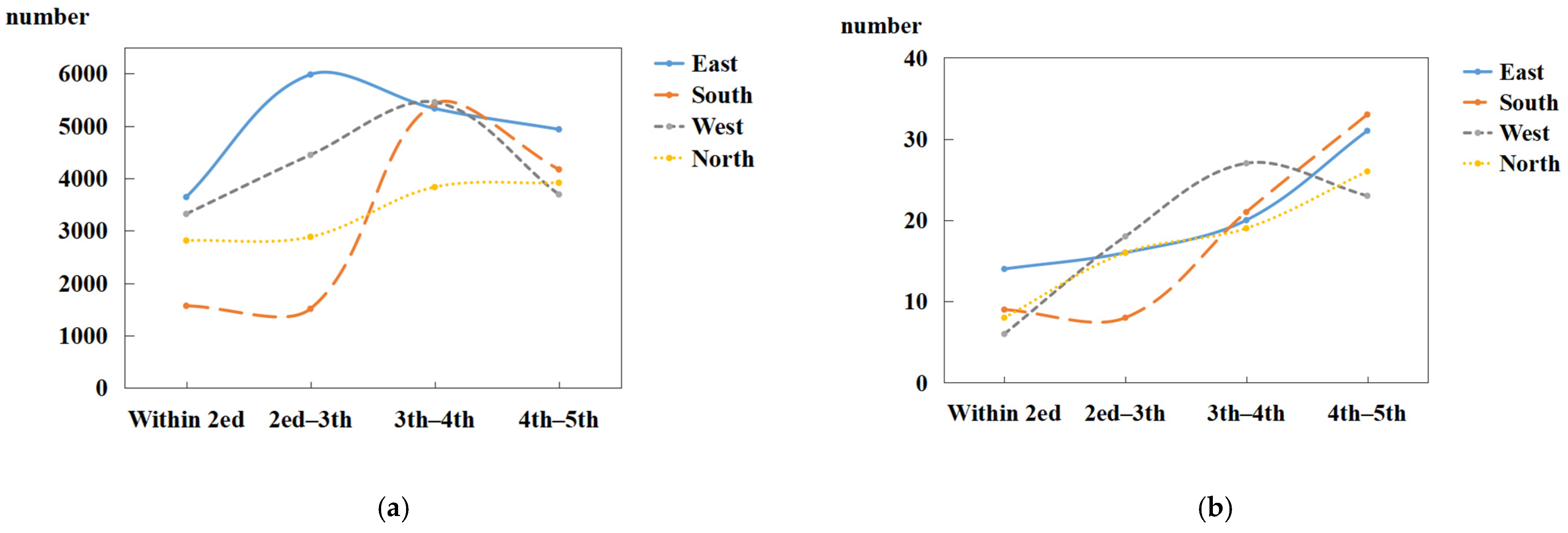

References
- Lee, G.; Hong, I. Measuring spatial accessibility in the context of spatial disparity between demand and supply of urban park service. Landsc. Urban Plan. 2013, 119, 85–90. [Google Scholar] [CrossRef]
- Guy, C.M. The assessment of access to local shopping opportunities: A comparison of accessibility measures. Environ. Plan. B Plan. Des. 1983, l0, 219–237. [Google Scholar] [CrossRef]
- Hansen, W.G. How accessibility shapes land use. J. Am. Inst. Plann. 1959, 25, 73–76. [Google Scholar] [CrossRef]
- Tao, Z.L.; Cheng, Y.; Liu, J. Hierarchical two-step floating catchment area (2sfca) method: Measuring the spatial accessibility to hierarchical healthcare facilities in Shenzhen, China. Int. J. Equity Health. 2020, 19, 164. [Google Scholar] [CrossRef] [PubMed]
- Khan, A.A. An integrated approach to measuring potential spatial access to health care services. Socioecon. Plann Sci. 1992, 26, 275–287. [Google Scholar] [CrossRef]
- Dalvi, M.Q.; Martin, K.M. The measurement of accessibility: Some preliminary results. Transportation 1976, 5, 17–42. [Google Scholar] [CrossRef]
- Berechman, J. Transportation, temporal, and spatial components of accessibility, by Lawrence, D. Burns. Geogr. Anal. 2010, 13, 185–187. [Google Scholar] [CrossRef]
- Su, S.L.; Li, Z.K.; Xu, M.Y. A geo-big data approach to intra-urban food deserts: Transit-varying accessibility, social inequalities, and implications for urban planning. Habitat Int. 2017, 64, 22–40. [Google Scholar] [CrossRef]
- Charreire, H.; Casey, R.; Salze, P. Measuring the food environment using geographical information systems: A methodological review. Public Health Nutr. 2010, 13, 1773–1785. [Google Scholar] [CrossRef]
- Shearer, C.; Rainham, D.; Blanchard, C. Measuring food availability and accessibility among adolescents: Moving beyond the neighbourhood boundary. Soc. Sci. Med. 2015, 133, 322–330. [Google Scholar] [CrossRef]
- Zhang, L.; Zhou, J.; Hui, C.M. Which types of shopping malls affect housing prices? From the perspective of spatial accessibility. Habitat Int. 2020, 96, 102118. [Google Scholar] [CrossRef]
- Zhou, J.T. The Effects of Spatial Accessibility to Shopping Centers on Housing Prices: A Case of Hangzhou, China. Shopping Center Accessibility on Housing Prices. Ph.D. Thesis, Zhejiang University, Hangzhou, China, 2019. [Google Scholar]
- Lu, Y.W.; Hong, F.; Yan, K.W. Site selection of retail shops based on spatial accessibility and hybrid bp neural network. ISPRS Int. Geo-Inf. 2018, 7, 202. [Google Scholar]
- Ner, Z. Retail city: The relationship between place attractiveness and accessibility to shops. Work. Pap. Ser. 2015, 12, 1–20. [Google Scholar] [CrossRef][Green Version]
- Arranz-López, A.; Soria-Lara, J.A.; Pueyo-Campos, N. Social and spatial equity effects of non-motorised accessibility to retail. Cities 2019, 86, 71–82. [Google Scholar] [CrossRef]
- Morris, J.M.; Dumble, P.L.; Wigan, M.R. Accessibility indicators for transport planning. Transport. Res. Part A Gen. 1979, 13, 91–109. [Google Scholar] [CrossRef]
- Batty, M. Urban Modelling: Algorithms, Calibrations, Predictions; Cambridge University Press: Cambridge, UK, 1976. [Google Scholar]
- Deboosere, R.; El-Geneidy, A. Evaluating equity and accessibility to jobs by public transport across Canada. J. Transp. Geogr. 2018, 73, 54–63. [Google Scholar] [CrossRef]
- Kwan, M.P. Space-time and integral measures of individual accessibility: A comparative analysis using a point-based framework. Geogr. Anal. 2010, 30, 191–216. [Google Scholar] [CrossRef]
- Tao, Z.L.; Cheng, Y.; Dai, T.Q. Measuring spatial accessibility to residential care facilities in Beijing. Progr. Geogr. 2014, 33, 616–624. (In Chinese) [Google Scholar]
- Widener, M.J. Comparing measures of accessibility to urban supermarkets for transit and auto users. Prof. Geogr. 2017, 69, 362–371. [Google Scholar] [CrossRef]
- Handy, S.L.; Clifton, K.J. Local shopping as a strategy for reducing automobile travel. Transportation 2001, 28, 317–346. [Google Scholar] [CrossRef]
- Li, A.; Chen, J.; Qian, T.; Zhang, W.; Wang, J. Spatial accessibility to shopping malls in Nanjing, China: Comparative analysis with multiple transportation modes. Chin. Geogr. Sci. 2020, 30, 710–724. [Google Scholar] [CrossRef]
- Thornton, L.E.; Pearce, J.R.; Kavanagh, A.M. Using geographic information systems (GIS) to assess the role of the built environment in influencing obesity: A glossary. Int. J. Behav. Nutr. Phys. Act. 2011, 8, 71. [Google Scholar] [CrossRef] [PubMed]
- Soria-Lara, J.A.; Arranz-López, A.; Badía-Lázaro, R. Evaluating relative accessibility to retail in depopulated areas: Case study of the Maestrazgo region in Spain. Adv. Transp. Policy Plan. 2018, 2, 81–106. [Google Scholar]
- Zhang, J.; Mao, L. Integrating multiple transportation modes into measures of spatial food accessibility. J. Transp. Health 2019, 13, 1–11. [Google Scholar] [CrossRef]
- Radke, J.; Mu, L. Spatial decompositions, modeling and mapping service regions to predict access to social programs. Geogr. Inf. Sci. 2000, 6, 105–112. [Google Scholar] [CrossRef]
- Xing, L.; Liu, Y.; Liu, X. Measuring spatial disparity in accessibility with a multi-mode method based on park green spaces classification in Wuhan, China. Appl. Geogr. 2018, 94, 251–261. [Google Scholar] [CrossRef]
- Xing, L.; Liu, Y.; Liu, X.; Wei, X.; Mao, Y. Spatio-temporal disparity between demand and supply of park green space service in urban area of Wuhan from 2000 to 2014. Habitat Int. 2018, 71, 49–59. [Google Scholar] [CrossRef]
- Xing, L.; Liu, Y.; Wang, B.; Wang, Y.; Liu, H. An environmental justice study on spatial access to parks for youth by using an improved 2SFCA method in Wuhan, China. Cities 2020, 96, 102405. [Google Scholar] [CrossRef]
- Luo, W.; Qi, Y. An enhanced two-step floating catchment area (E2SFCA) method for measuring spatial accessibility to primary care physicians. Health Place 2009, 15, 1100–1107. [Google Scholar] [CrossRef]
- Kanuganti, S.; Sarkar, A.K.; Singh, A.P. Evaluation of access to health care in rural areas using enhanced two-step floating catchment area (E2SFCA) method. J. Transp. Geogr. 2016, 56, 45–52. [Google Scholar] [CrossRef]
- Gong, S.Z.; Gao, Y.; Zhang, F.; Mu, L.; Liu, Y. Evaluating healthcare resource inequality in Beijing, China based on an improved spatial accessibility measurement. Trans. GIS. 2021, 25, 1504–1521. [Google Scholar] [CrossRef]
- Qin, J.H.; Liu, Y.S.; Yi, D.S.; Sun, S.; Zhang, J. Spatial accessibility analysis of parks with multiple entrances based on real-time travel: The case study in Beijing. Sustainability 2020, 12, 7618. [Google Scholar] [CrossRef]
- The People’s Government of Beijing Municipality. Available online: http://www.beijing.gov.cn/ (accessed on 10 June 2021).
- Lynch, K. Good City Form; MIT Press: Cambridge, MA, USA, 1984. [Google Scholar]
- Bryanat, J., Jr.; Delamater, P.L. Examination of spatial accessibility at micro- and macro-levels using the enhanced two-step floating catchment area (e2sfca) method. Ann. GIS 2019, 25, 219–229. [Google Scholar] [CrossRef]
- Baidu Map Open Platform. Available online: http://lbsyun.baidu.com/ (accessed on 10 June 2021).
- Xu, X.Y.; Li, M. Analysis on spatial distribution pattern of Beijing restaurants based on open source big data. Geogr. Sci. 2019, 21, 215–255. (In Chinese) [Google Scholar]
- Rodriguez, A.; Laio, A. Clustering by fast search and find of density peaks. Science 2014, 344, 1492–1496. [Google Scholar] [CrossRef]
- Xie, J.; Gao, H.; Xie, W.; Liu, X.; Grant, P.W. Robust clustering by detecting density peaks and assigning points based on fuzzy weighted k-nearest neighbors. Inf. Sci. 2016, 354, 19–40. [Google Scholar] [CrossRef]
- Wang, Y.; Zhang, G.Z. Automatically determine density of cluster center of peak algorithm. Comput. Eng. Appl. 2018, 54, 137–142. (In Chinese) [Google Scholar]
- Huff, D.L. A probabilistic analysis of shopping center trade areas. Land Econ. 1963, 39, 81–90. [Google Scholar] [CrossRef]
- Yue, Y.; Wang, H.; Hu, B.; Li, Q.; Li, G.; Yeh, A. Exploratory calibration of a spatial interaction model using taxi GPS trajectories. Comput. Environ. Urban Syst. 2012, 36, 140–153. [Google Scholar] [CrossRef]
- Mao, L.; Nekorchuk, D. Measuring spatial accessibility to healthcare for populations with multiple transportation modes. Health Place 2013, 24, 115–122. [Google Scholar] [CrossRef]
- Cheng, G.; Zeng, X.; Duan, L.; Lu, X.; Sun, H.; Jiang, T.; Li, Y. Spatial difference analysis for accessibility to high level hospitals based on travel time in Shenzhen, China. Habitat Int. 2016, 53, 485–494. [Google Scholar] [CrossRef]
- Luo, W.; Wang, F. Measures of spatial accessibility to health care in a GIS environment: Synthesis and a case study in the Chicago region. Environ. Plan. B Plan. Des. 2003, 30, 865–884. [Google Scholar] [CrossRef] [PubMed]
- Tao, Z.L.; Cheng, Y. Modelling the spatial accessibility of the elderly to healthcare services in Beijing, China. Environ. Plan. B Urban Anal. City Sci. 2019, 46, 1132–1147. [Google Scholar] [CrossRef]
- Moran, P.A. The interpretation of statistical maps. J. R. Stat. Soc. Ser. B-Stat. Methodol. 1948, 10, 243–251. [Google Scholar] [CrossRef]
- Wang, F.H. Quantitative Methods and Application in GIS; CRC Press: Boca Raton, FL, USA, 2006; Volume 60, pp. 434–435. [Google Scholar]
- Wang, L.; Cao, X.; Li, T.; Gao, X. Accessibility comparison and spatial differentiation of Xi’an scenic spots with different modes based on Baidu real-time travel. Chin. Geogr. Sci. 2019, 29, 848–860. [Google Scholar] [CrossRef]
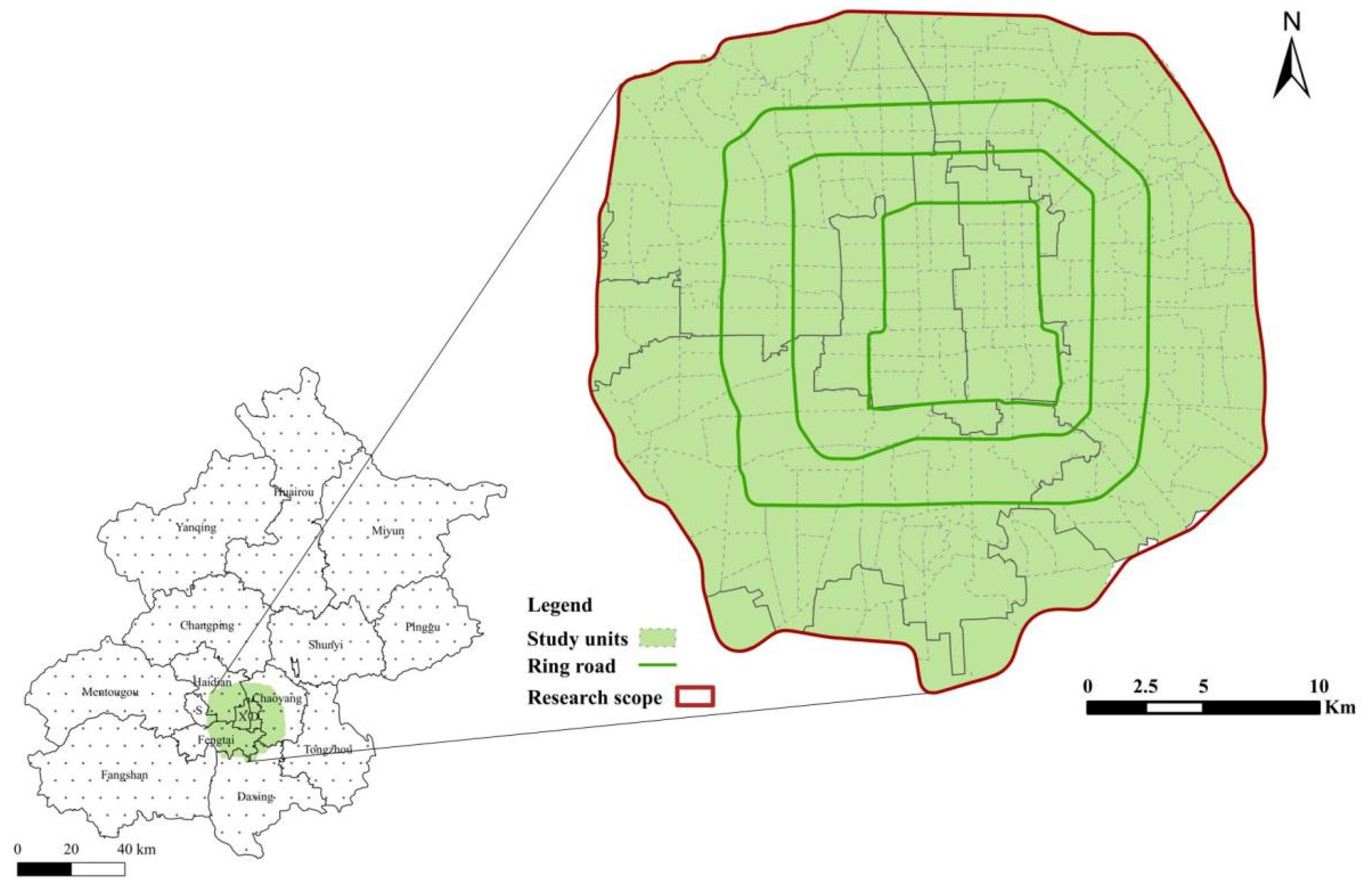
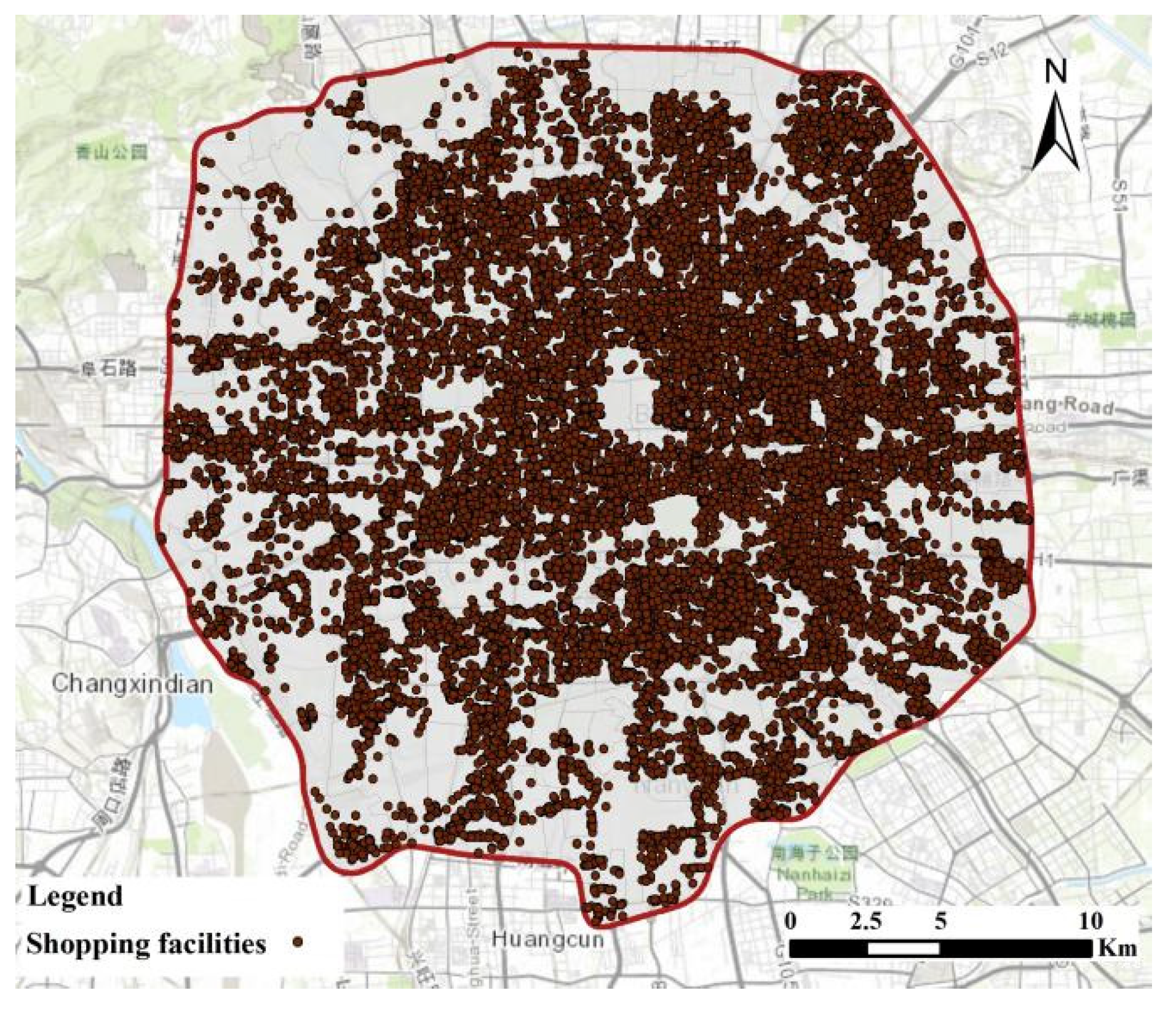
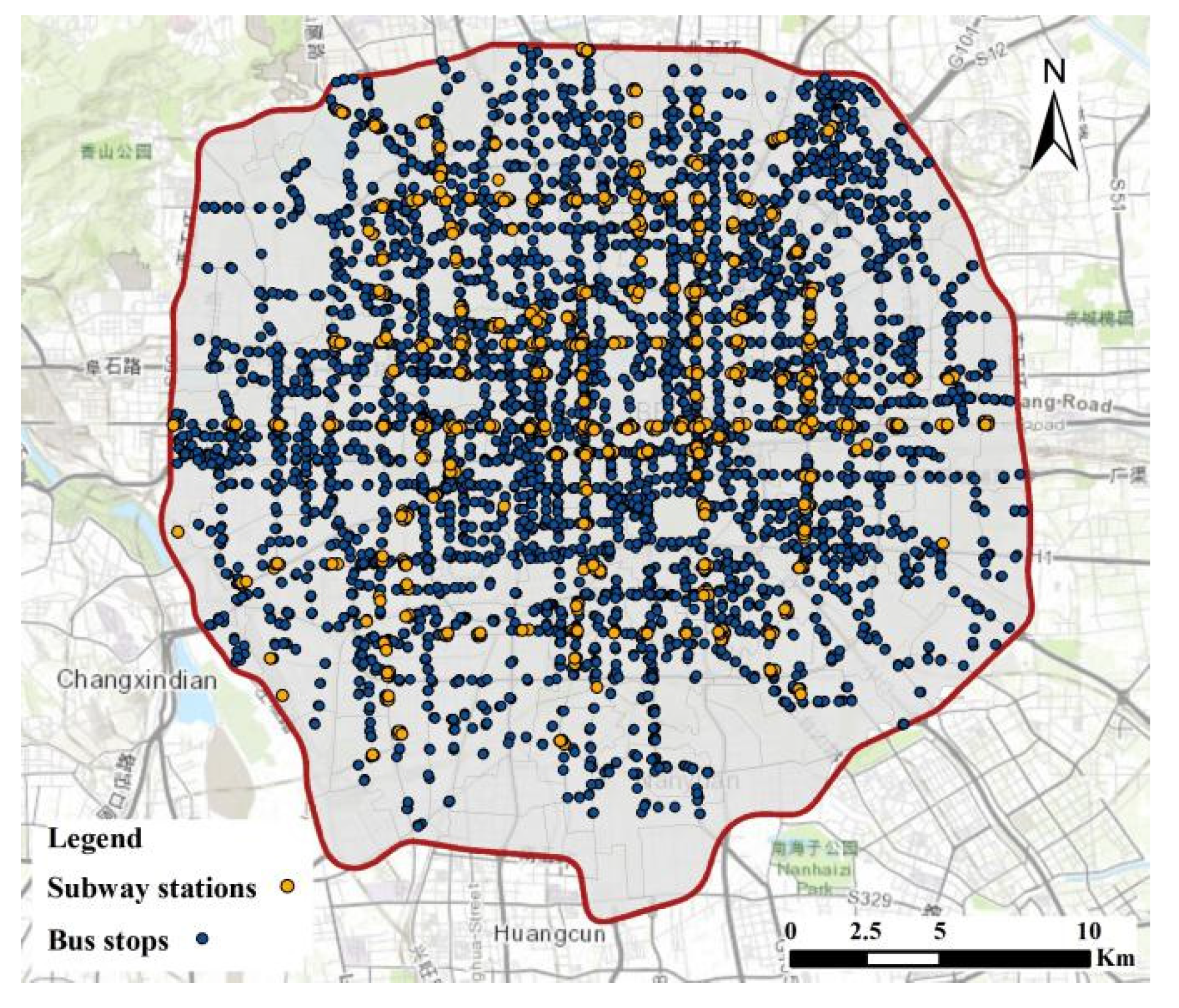
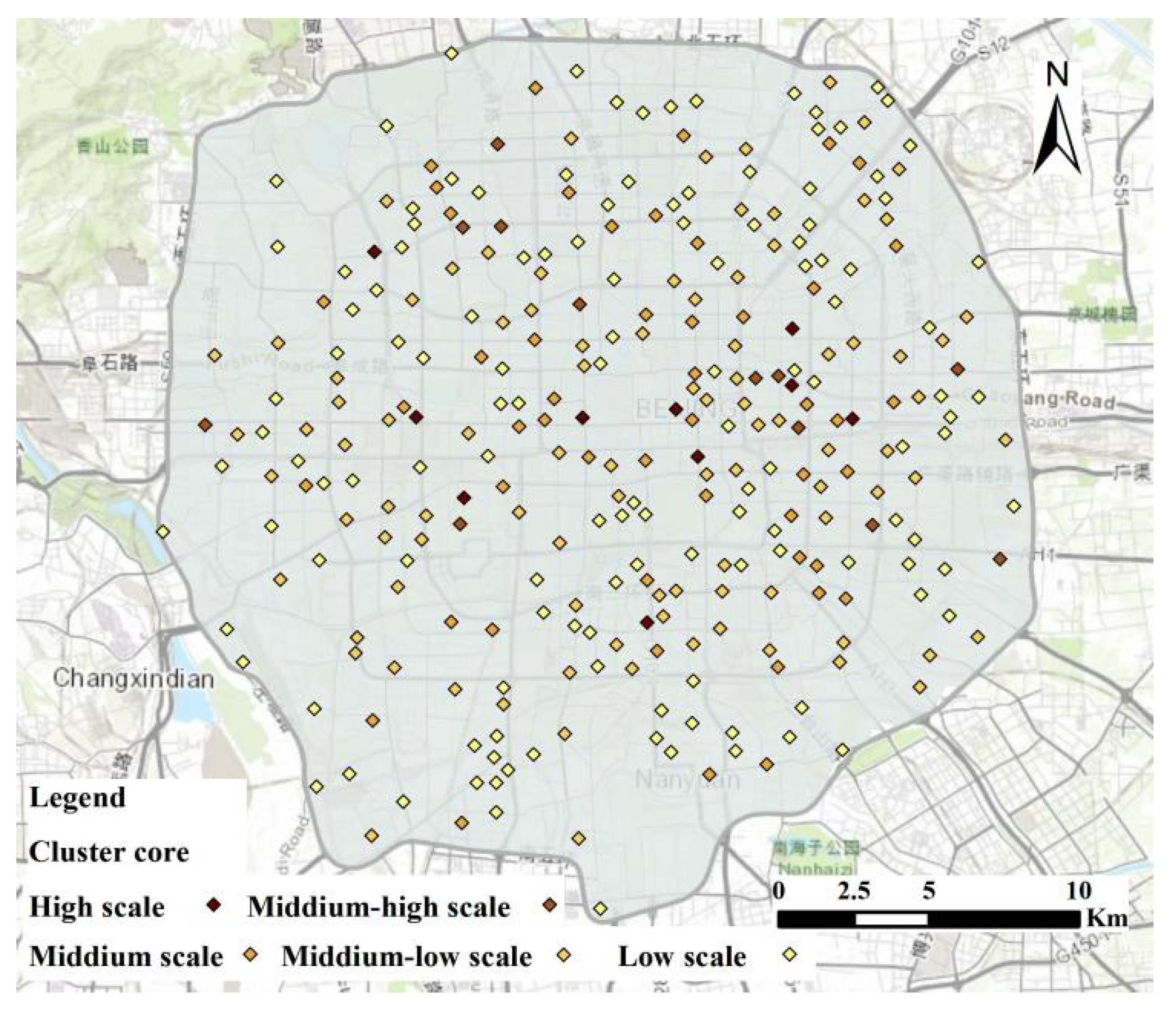
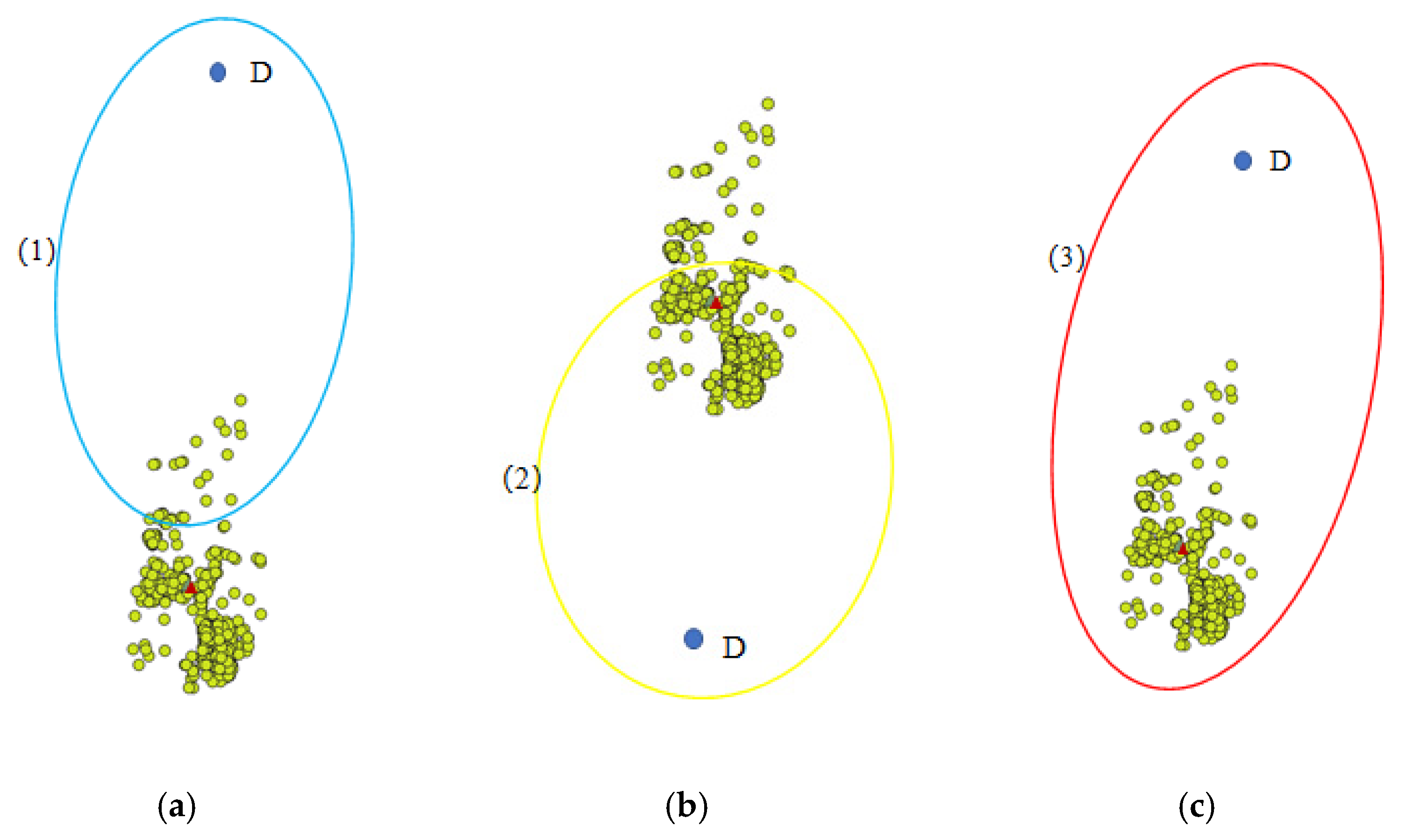
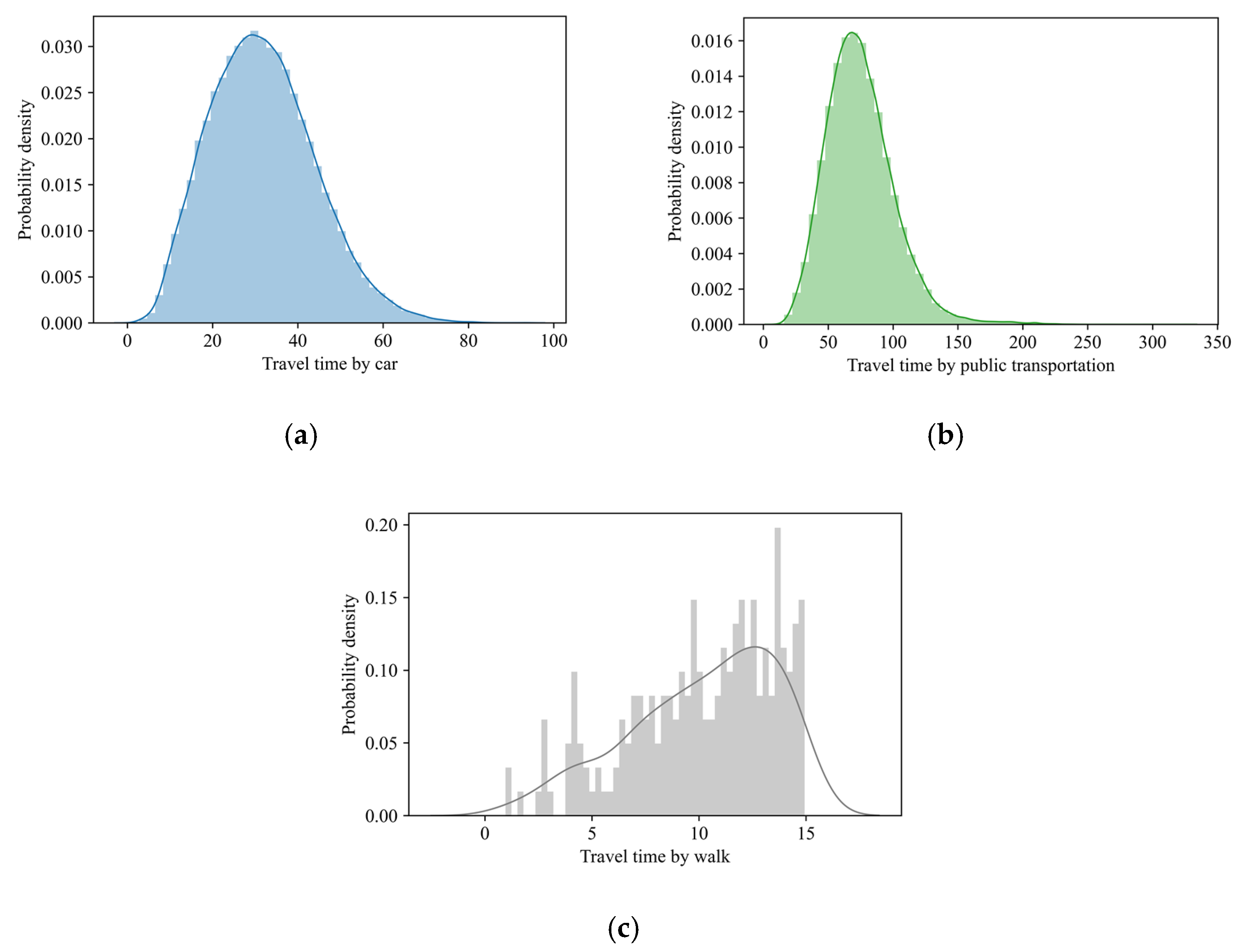
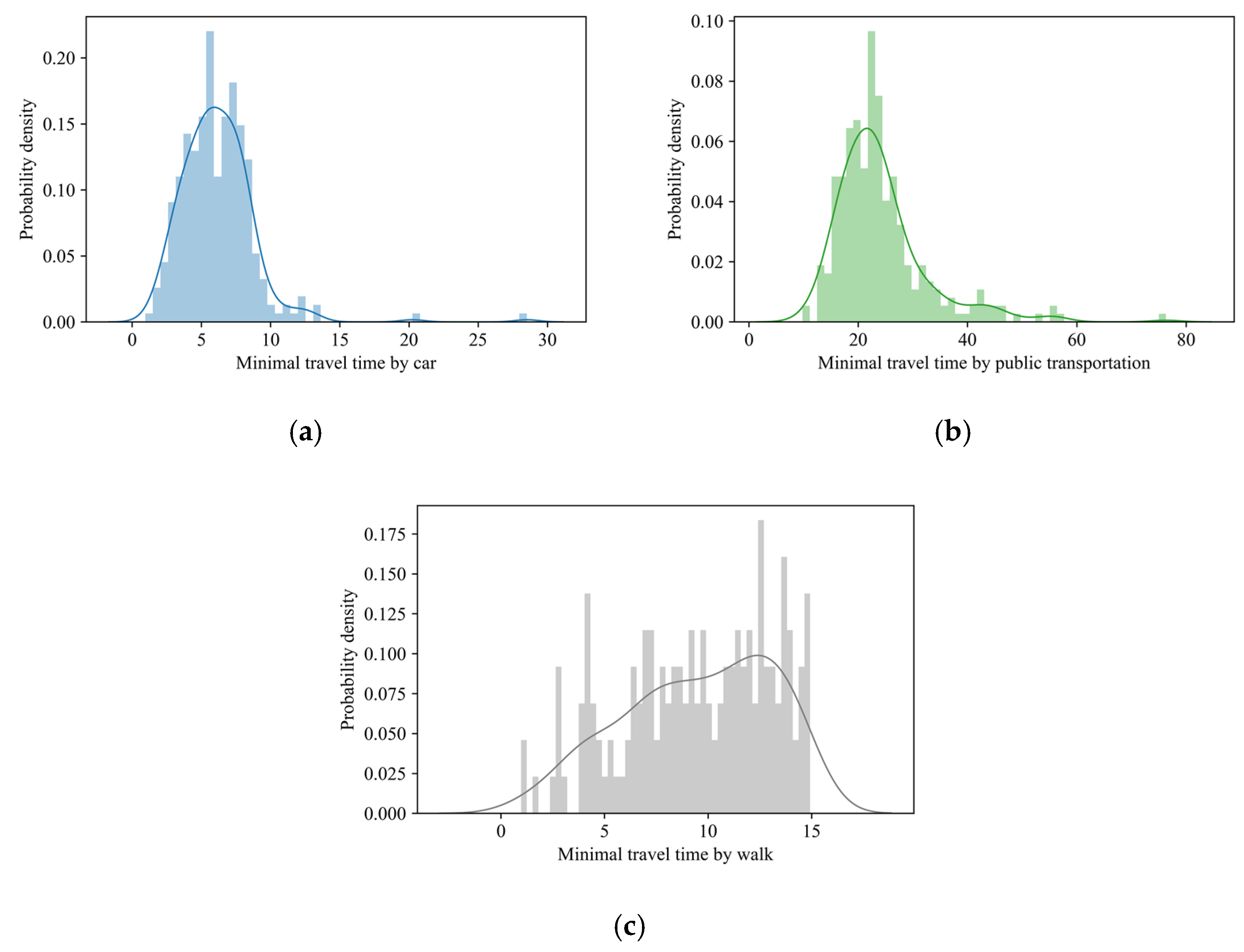
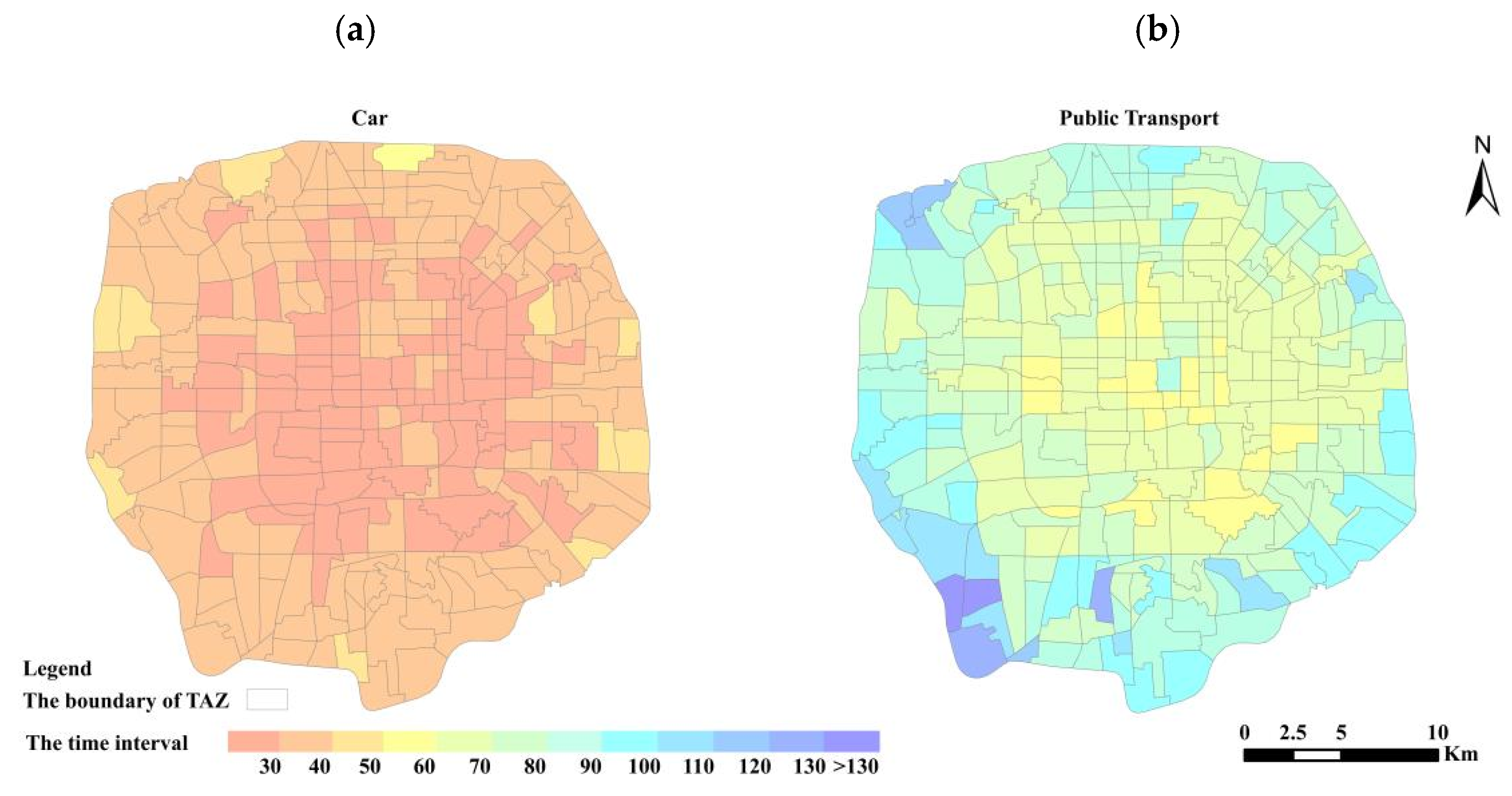
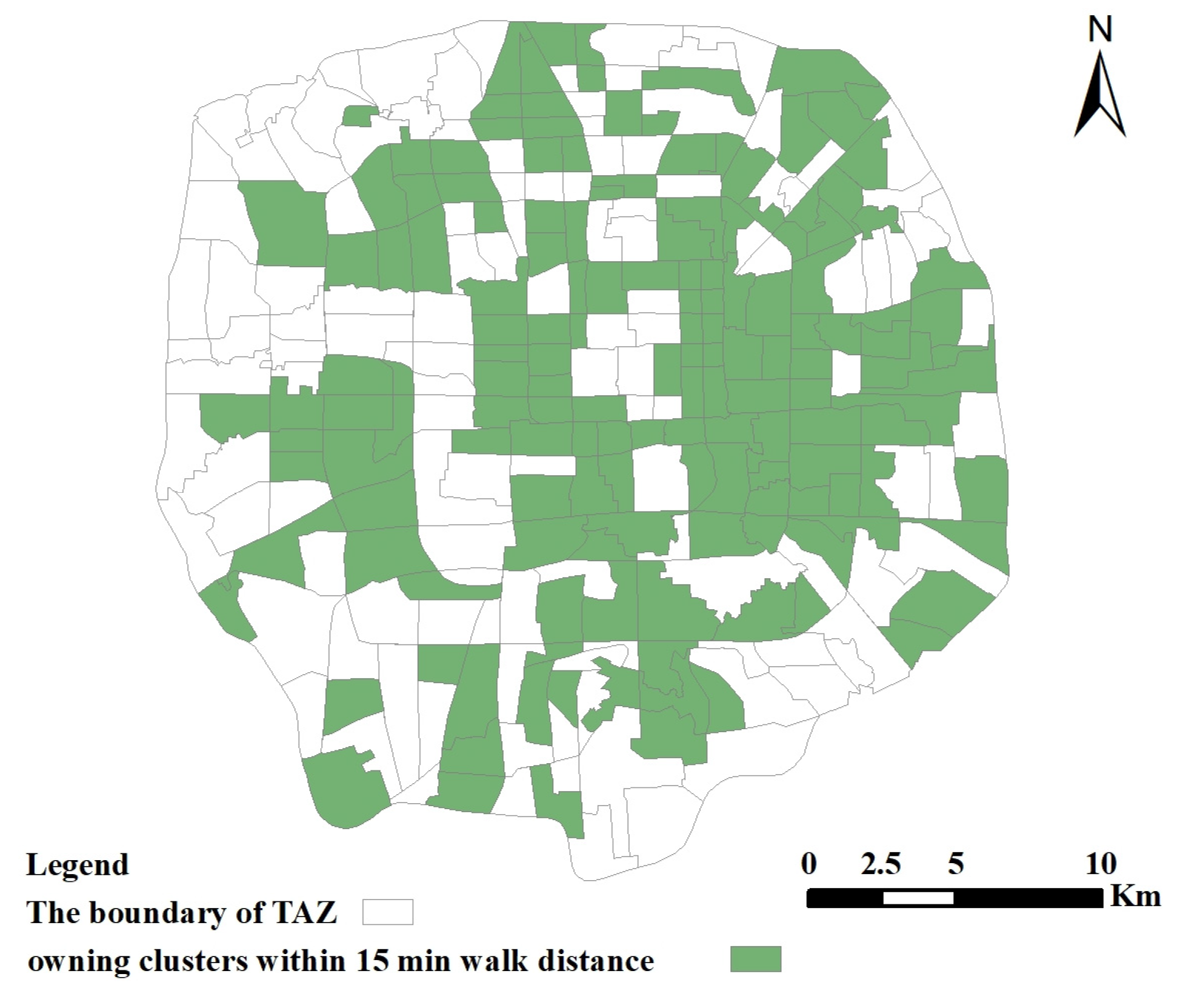

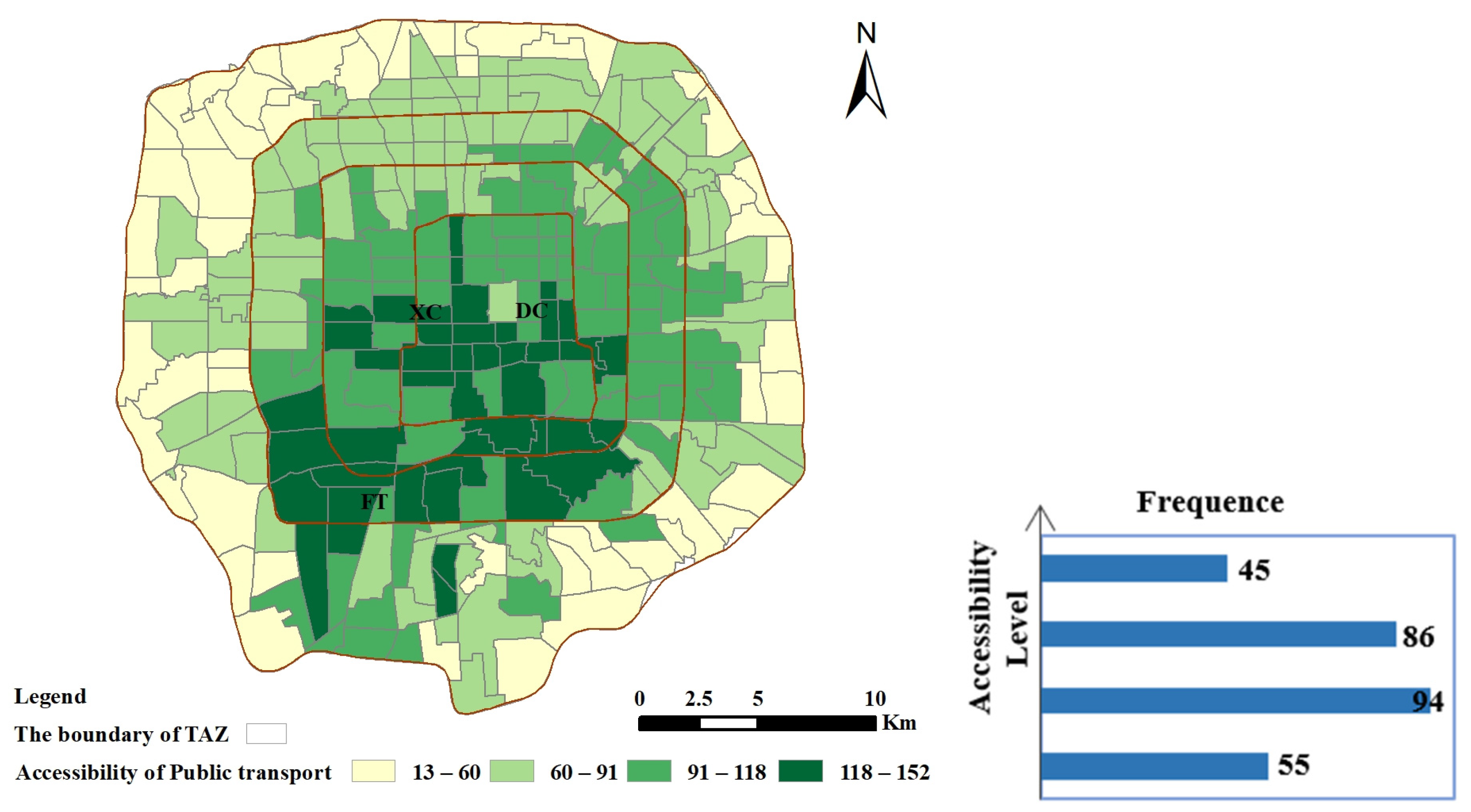
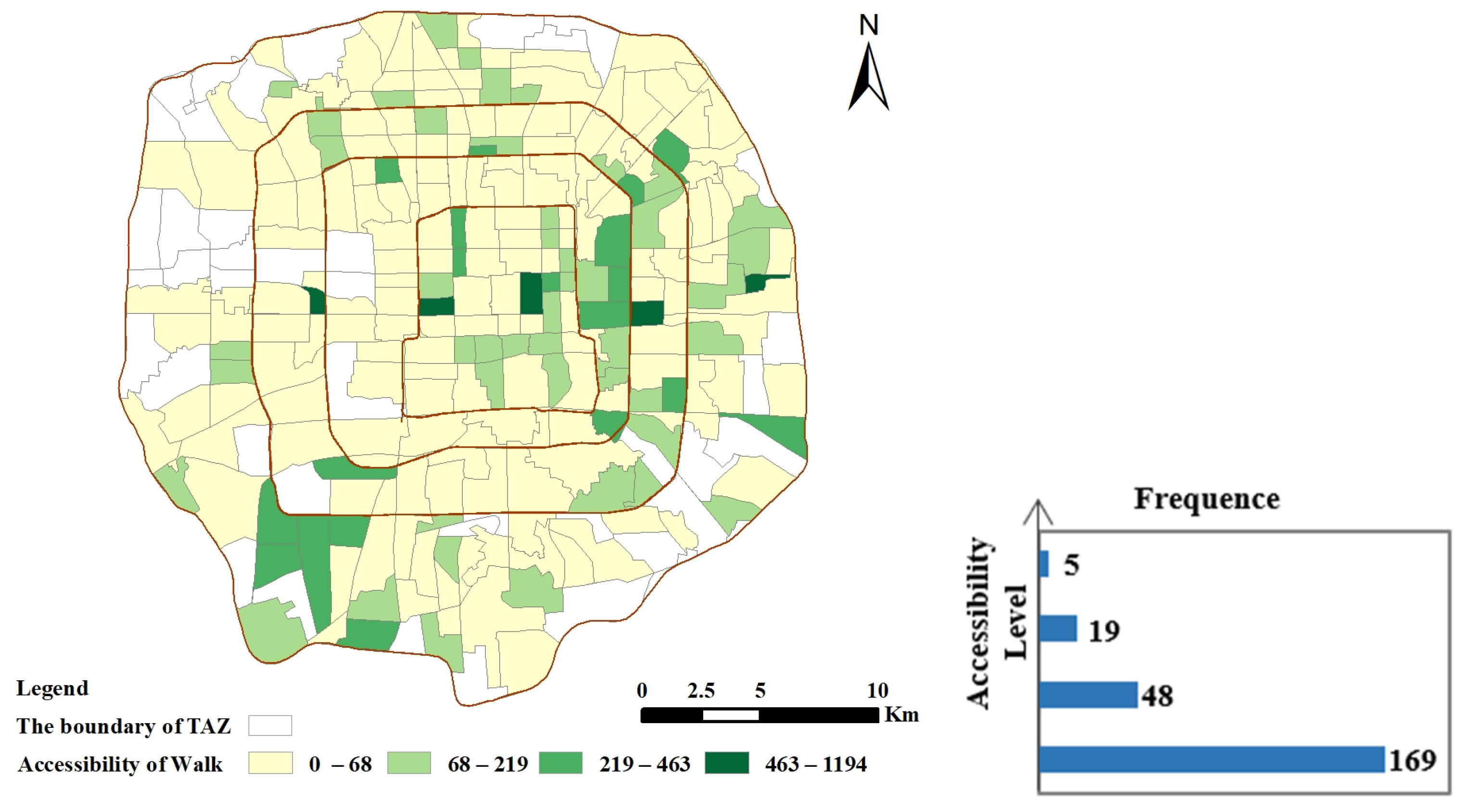
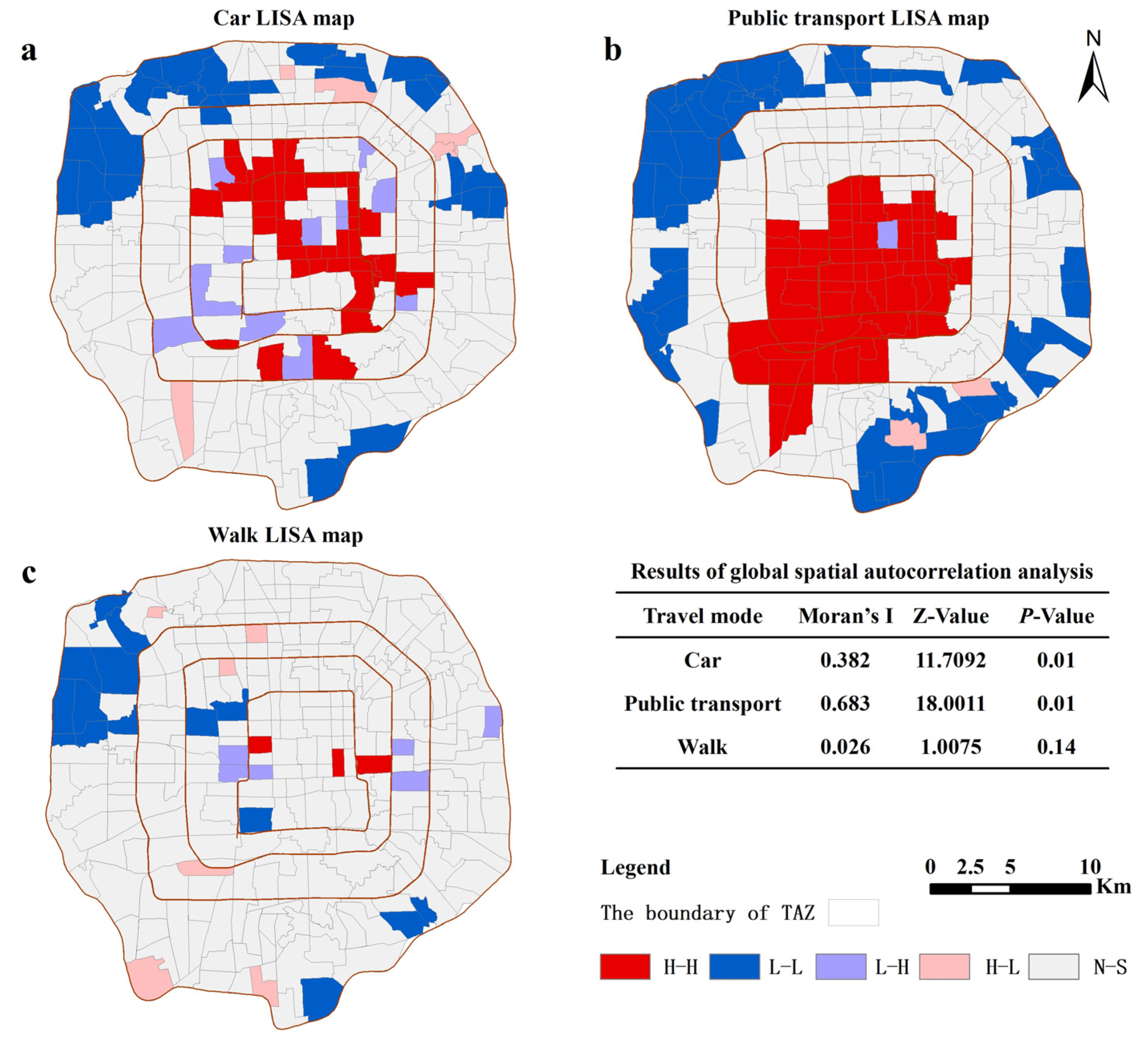

Publisher’s Note: MDPI stays neutral with regard to jurisdictional claims in published maps and institutional affiliations. |
© 2022 by the authors. Licensee MDPI, Basel, Switzerland. This article is an open access article distributed under the terms and conditions of the Creative Commons Attribution (CC BY) license (https://creativecommons.org/licenses/by/4.0/).
Share and Cite
Qin, J.; Luo, S.; Yi, D.; Jiang, H.; Zhang, J. Measuring Cluster-Based Spatial Access to Shopping Stores under Real-Time Travel Time. Sustainability 2022, 14, 2310. https://doi.org/10.3390/su14042310
Qin J, Luo S, Yi D, Jiang H, Zhang J. Measuring Cluster-Based Spatial Access to Shopping Stores under Real-Time Travel Time. Sustainability. 2022; 14(4):2310. https://doi.org/10.3390/su14042310
Chicago/Turabian StyleQin, Jiahui, Shijia Luo, Disheng Yi, Heping Jiang, and Jing Zhang. 2022. "Measuring Cluster-Based Spatial Access to Shopping Stores under Real-Time Travel Time" Sustainability 14, no. 4: 2310. https://doi.org/10.3390/su14042310
APA StyleQin, J., Luo, S., Yi, D., Jiang, H., & Zhang, J. (2022). Measuring Cluster-Based Spatial Access to Shopping Stores under Real-Time Travel Time. Sustainability, 14(4), 2310. https://doi.org/10.3390/su14042310





